General
What Is Web Designing? A Comprehensive Overview of Its Principles and Practices
Overview
Web design represents the strategic planning and development of online platforms, concentrating on crucial elements such as layout, content, and aesthetics to enhance user experience and brand perception. Effective web design not only attracts visitors; it significantly improves engagement and conversion rates through well-organized layouts and appealing visuals. This is evidenced by case studies that illustrate substantial increases in user interactions following design improvements.
Introduction
In the digital age, where a brand’s online presence can make or break its reputation, the significance of web design has never been more critical. It transcends mere aesthetics; effective web design is a strategic blend of layout, user experience, and branding that fundamentally shapes how visitors perceive and interact with a company.
As businesses navigate a landscape increasingly dominated by rapid technological advancements and shifting consumer behaviors, understanding the nuances of web design becomes essential.
This exploration delves into the key elements that define successful web design in today’s competitive market, from the vital role of user experience to the essential tools that streamline the design process.
With insights into future trends and innovations, this article equips brands with the knowledge to enhance their digital footprint and foster deeper connections with their audience.
Understanding Web Design: Definition and Importance
Web design involves the strategic planning and development of online platforms, integrating critical elements such as layout, content production, and graphic design. Its significance cannot be overstated; it fundamentally shapes customer perception and interaction with a brand. A thoughtfully crafted website not only attracts visitors but also significantly enhances user experience, fostering higher engagement and conversion rates.
In an era where initial perceptions are predominantly formed online, effective website aesthetics serve as the cornerstone of a successful branding strategy.
As we approach 2025, the role of web creation in branding has become increasingly pronounced. Research indicates that the first five seconds of page-load duration have the most substantial impact on conversion rates, underscoring the necessity for quick and effective layouts. Experts emphasize the importance of considering visual components—such as images, colors, and videos—in website creation to enhance audience engagement.
Kerry Hounslea, a content writer, observes, “Research examines the visual components to take into account in your website layout – photos/images, color, and videos.” For instance, Orah, a student engagement platform, revamped their homepage layout to better cater to first-time visitors, resulting in a remarkable 63.27% increase in demo request clicks. This case study illustrates how strategic website creation can directly influence visitor behavior and brand perception.
Furthermore, statistics reveal that effective website layout can lead to improved visitor engagement, with well-organized sites encouraging individuals to explore further and engage more deeply with content. The combination of intuitive navigation and appealing aesthetics not only captivates individuals but also fortifies brand identity. With a team of 500 award-winning specialists, WonderEight focuses on innovative web development solutions tailored to enhance brand identity and market presence.
Our portfolio showcases successful projects that demonstrate the effectiveness of our strategies, such as [insert specific case study or testimonial]. As brands continue to navigate the digital landscape, understanding the intricacies of web design remains crucial as an essential element of branding strategies, enhancing both audience interaction and conversion achievements.
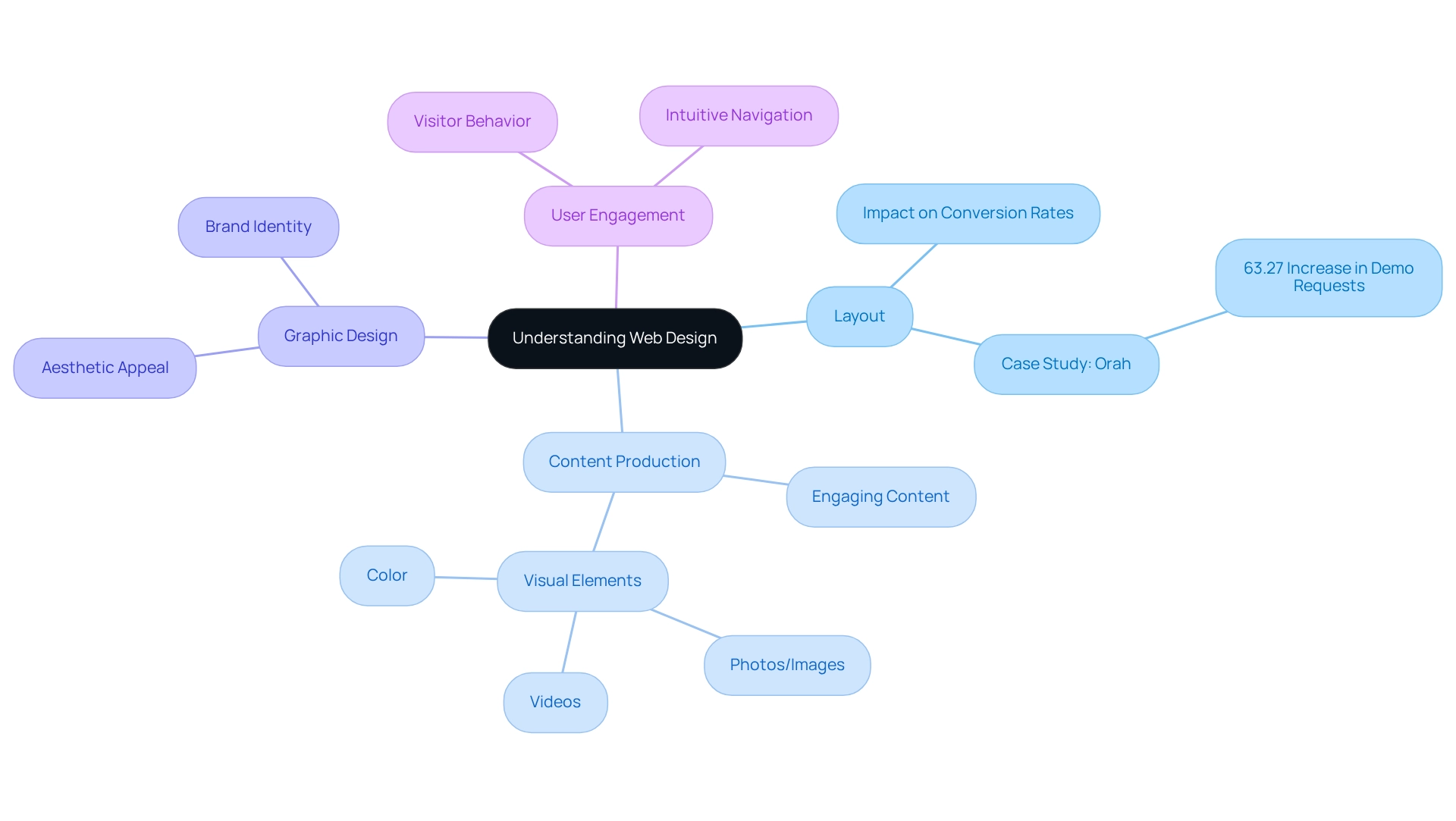
Key Elements of Effective Web Design
Effective web design relies on several essential elements that collectively enhance experience and engagement:
- Layout: The strategic arrangement of visual components on a webpage is crucial, guiding navigation and interaction. A well-organized layout significantly affects how individuals perceive and engage with content. Notably, the first 5 seconds of page-load time can dramatically impact conversion rates, making layout optimization essential.
- Color Scheme: Selecting a color palette that aligns with the brand’s identity is vital. Colors not only represent the brand but also evoke specific emotions, influencing audience perception and engagement.
- Typography: The selection of fonts plays a significant role in enhancing readability and conveying the brand’s personality. Effective typography ensures that content is accessible and visually appealing, contributing to a positive experience for individuals.
- Imagery: The incorporation of images and graphics is crucial for enhancing content and attracting attention. Research indicates that 40% of consumers prioritize photos and images over other design elements, highlighting their significance in maintaining audience interest. This aligns with findings that leading firms in customer experience exceed the S&P index with over 3x returns, emphasizing the importance of effective design.
- Navigation: A clear and intuitive navigation structure is essential for allowing individuals to find information effortlessly. Statistics indicate that efficient navigation can result in a 73.30% increase in traffic, underscoring its essential role in audience engagement.
Each of these components is vital to forming a cohesive and engaging experience. As web creation continues to evolve in 2025, understanding what web design entails and implementing these key components will be essential for brands aiming to enhance their online presence and drive user interaction. Furthermore, considering the average yearly membership expense for WordPress, which is $145, is crucial for brands planning their web development investments.
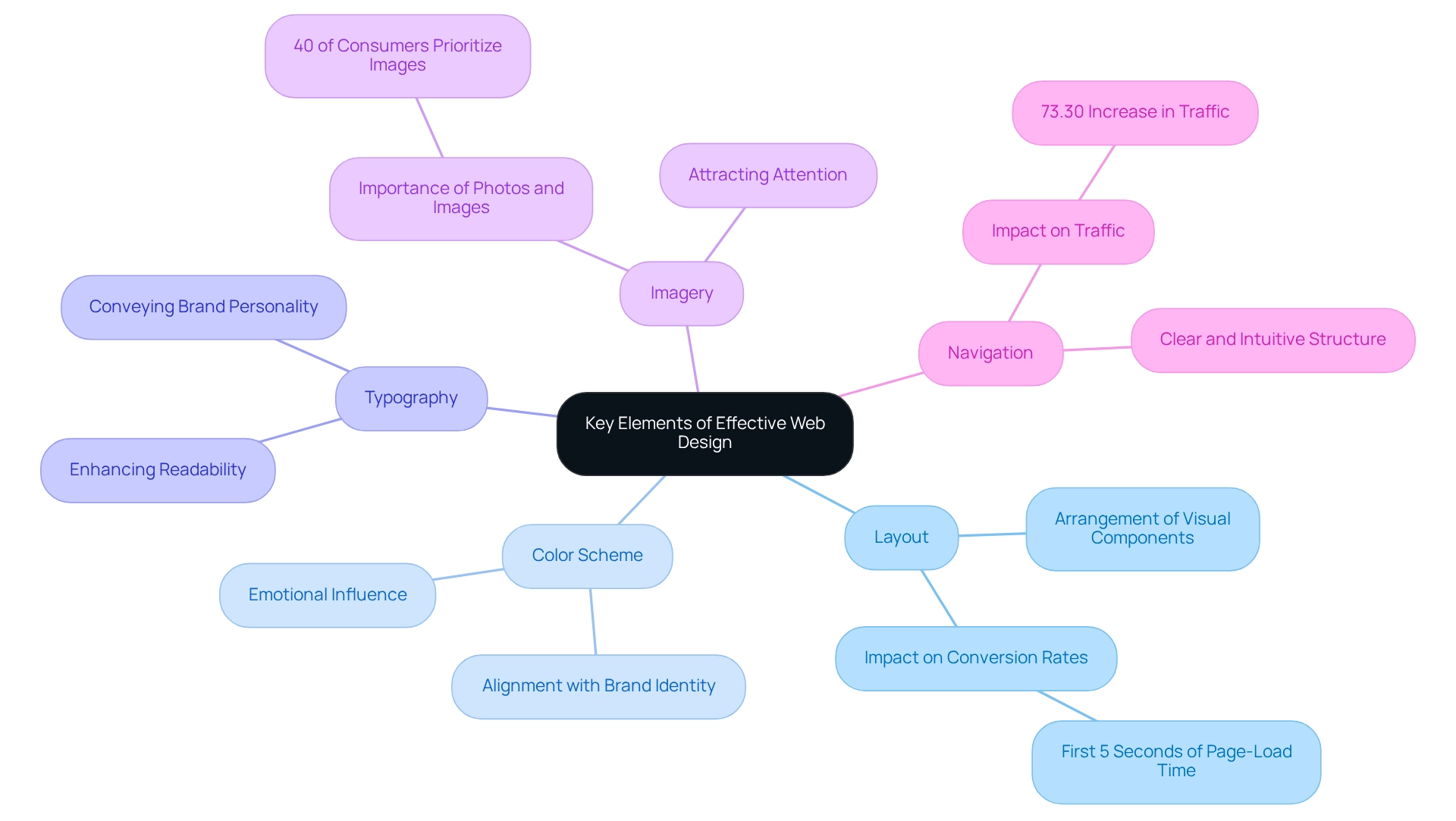
Web Design vs. Web Development: Understanding the Differences
Understanding what web designing entails requires recognizing that web creation and web development serve distinct yet complementary roles in establishing a website. What is web designing? It primarily focuses on visual elements and user experience, emphasizing aspects such as layout, color schemes, and overall aesthetics. Designers strive to create visually appealing and user-friendly interfaces that engage visitors and encourage interaction, thereby illustrating the essence of web designing.
Conversely, web development encompasses the technical execution of these concepts. Developers employ programming languages to build the website’s functionality, ensuring smooth and efficient operation. This distinction aids in grasping the nuances of web designing and highlights the differences between these two disciplines, particularly for businesses seeking to establish a robust online presence. Statistics reveal that effective website creation can significantly impact visitor engagement; for instance, Orah experienced a 63.27% increase in demo requests after enhancing their home page layout for new arrivals.
This underscores the critical role that design plays in attracting and retaining users. Moreover, successful collaborations between web designers and developers are essential for achieving optimal results. When these professionals unite their efforts, they can create a seamless user experience that not only looks appealing but also functions effectively. Case studies, such as the comprehensive campaigns executed for brands like Miranda and Quaker Oats, illustrate how integrated efforts can lead to increased consumer engagement and brand loyalty.
These campaigns exemplified WonderEight’s capacity to deliver meaningful brand experiences, resulting in quantifiable outcomes.
In summary, while web designers elucidate what web designing encompasses by emphasizing the aesthetic and experiential components of an online platform, web developers ensure its technical robustness. Both roles are indispensable for crafting a successful online platform, and their collaboration can yield measurable outcomes that enhance a brand’s digital presence. As Tom Shalin noted, the SEO process may not yield immediate results, yet effective website creation and development are crucial for long-term business success.
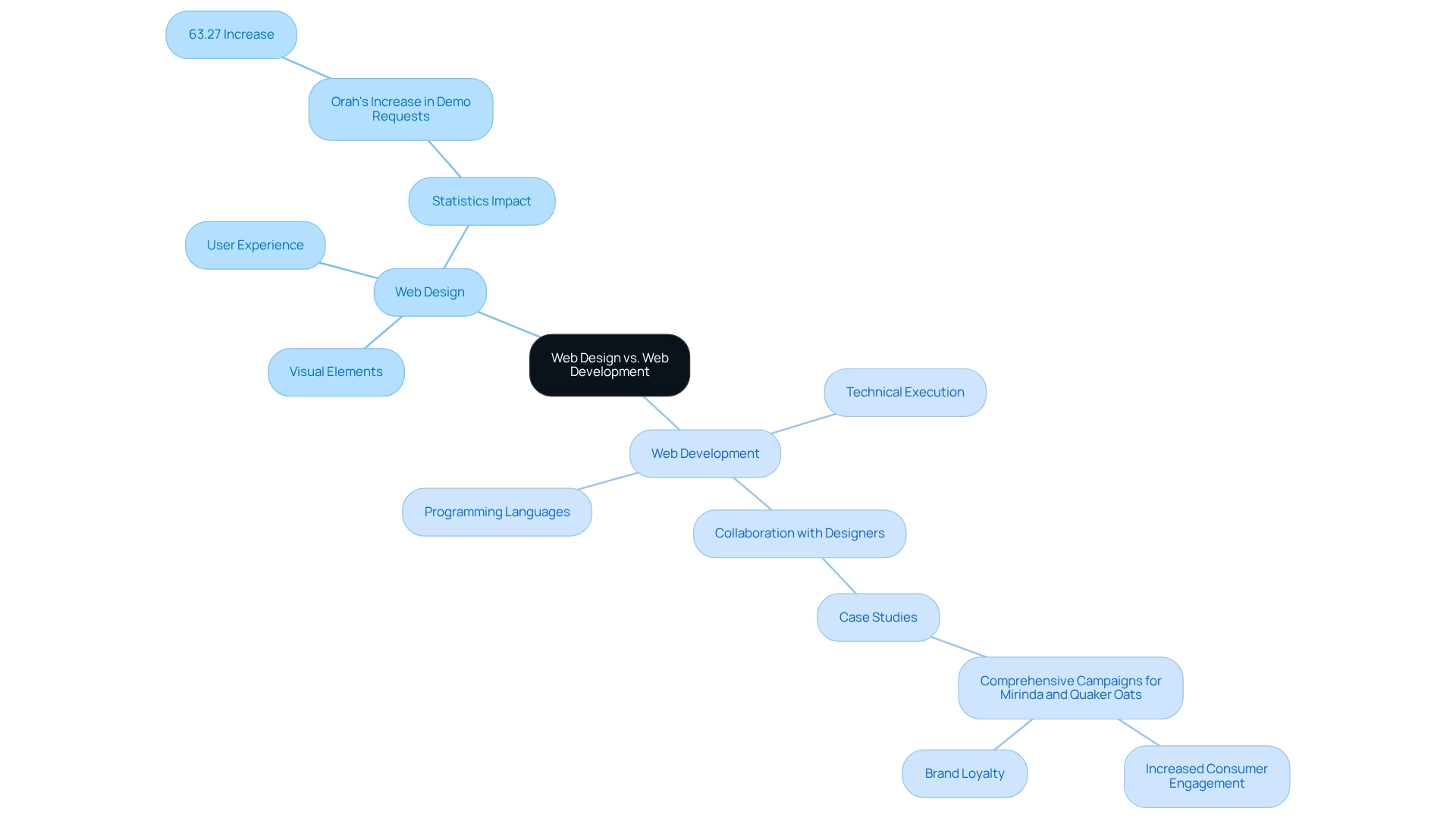
The Role of User Experience in Web Design
Experiencing the interface (UX) is a crucial component of understanding web design, as it focuses on the interactions individuals have with an online platform. Achieving a positive UX involves several key factors, including:
- Intuitive navigation
- Rapid loading times
- Responsive design that accommodates various devices
By prioritizing these aspects, designers can create platforms that not only satisfy client needs but also foster loyalty and promote return visits.
Research indicates that 91% of unhappy customers who do not express their concerns simply disengage, underscoring the significance of a smooth client experience. A well-organized platform that allows individuals to find information quickly can greatly reduce bounce rates and improve conversion rates, directly aiding a brand’s financial performance. For example, WonderEight’s tailored marketing strategy for Quaker Oats improved brand positioning and consumer loyalty, demonstrating the effectiveness of strategic UX enhancements in fostering brand loyalty.
As we look toward 2025, trends indicate that customers will increasingly favor speech interfaces for initiating self-service interactions, with projections suggesting that this will rise from 40% to 70%. This shift emphasizes the necessity for web layouts that include creative UX components to remain competitive and fulfill changing consumer expectations. Additionally, data shows that 32% of websites contain tappable features that are overly small, making navigation difficult for individuals. Addressing these issues is vital for enhancing engagement and loyalty among participants.
A seamless user experience can potentially enhance conversion rates by as much as 400%, according to a comprehensive Forrester Research study, emphasizing the significant influence of effective layout on business results.
In summary, web design highlights the significance of intuitive navigation and quick loading times in the domain of user experience. Websites that excel in these areas not only enhance user satisfaction but also drive measurable results, making them essential for brands aiming to thrive in a competitive digital landscape.
Essential Tools and Technologies for Web Designers
Web creators employ a diverse array of tools and technologies to craft effective websites, each serving distinct purposes that enhance the creation process. Key tools include:
- Adobe XD: This robust design tool is indispensable for creating wireframes and prototypes, allowing designers to visualize their ideas before implementation. Its user-friendly interface and integration capabilities streamline the creative workflow.
- Figma: Renowned for its collaborative features, Figma allows multiple users to work on a project simultaneously, making it ideal for teams. This real-time collaboration boosts creativity and accelerates the development process.
- Sketch: A vector graphics editor that has become a staple for web and mobile UI creation, Sketch offers powerful features tailored for crafting high-fidelity interfaces.
- WordPress: As a leading content management system, WordPress simplifies creation and management, making it accessible for users without extensive coding knowledge. Its vast library of plugins enhances functionality and customization.
- Webflow: This no-code platform empowers creators to build responsive websites visually, bridging the gap between aesthetics and development. Its capabilities provide greater flexibility and creativity in website development.
In 2025, familiarity with these tools is essential for enhancing a designer’s efficiency and creativity. For instance, usage statistics reveal that Adobe XD and Figma rank among the most favored tools, with Figma excelling in collaborative creative environments. Notably, a case study featuring TYKMA Electrox demonstrated that emphasizing key elements on their website resulted in an impressive 402% increase in total traffic, underscoring the impact of strategic selection.
Furthermore, the latest technologies in website creation, such as responsive frameworks and advanced analytics tools, are proving highly effective in optimizing user experience and engagement. A recent study emphasizes that the initial five seconds of page-load duration significantly influence conversion rates, highlighting the necessity for effective development practices. This aligns with insights shared by Elizabeth Romanski, who stated, “You don’t need a development background to make VWO work for you.”
The VWO support team is exceptional, further underscoring the accessibility of web development tools.
By integrating these essential tools and technologies, web designers can exemplify the essence of web design by creating compelling and effective websites that not only meet client expectations but also drive measurable results. For instance, WonderEight’s digital strategy for Quaker Oats enhanced their online marketing initiatives, resulting in greater engagement and sales, showcasing the agency’s expertise in website creation.
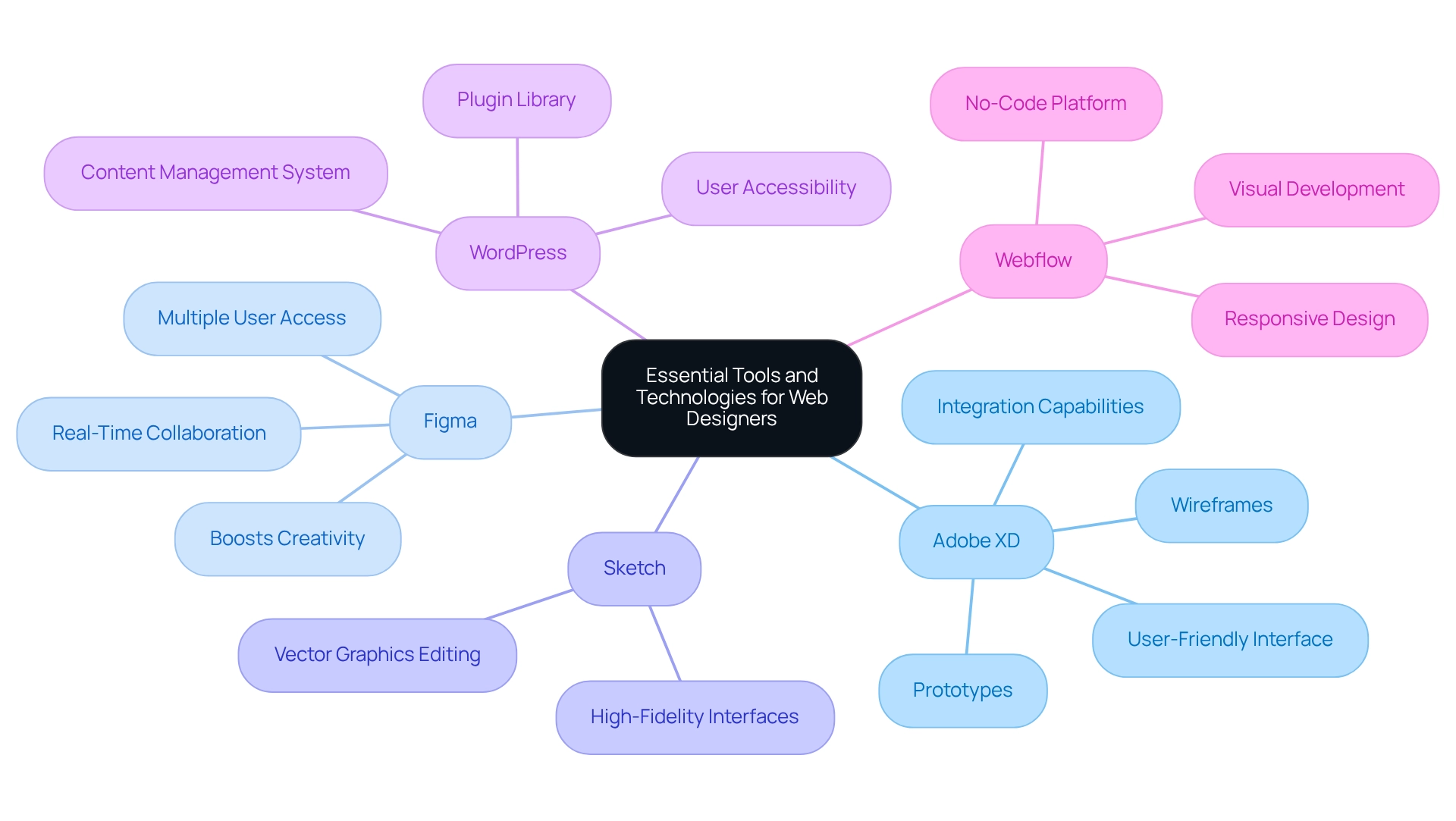
The Web Design Process: From Concept to Launch
The web design process represents a structured approach encompassing several critical stages, each contributing to the creation of an effective and user-friendly website:
-
Research and Planning: This foundational stage involves understanding the target audience and defining the goals of the site. Effective research is essential, as it guides design choices and ensures alignment with client needs. Statistics reveal that platforms tailored for mobile devices are crucial, with over 54.67% of web traffic originating from mobile visitors. A thoughtfully designed online platform can significantly enhance visitor interaction and loyalty.
-
Wireframing: In this phase, designers create a blueprint of the site layout, allowing stakeholders to visualize the structure and functionality before development begins. Wireframes serve as a framework for the creation process, ensuring that all components are strategically positioned to improve user experience.
-
Design: This stage focuses on crafting the visual elements of the site, including color schemes, typography, and imagery. Aesthetics play a vital role in user engagement; thus, the appearance must resonate with the target audience while maintaining brand consistency.
-
Development: Here, the design is transformed into a functional online platform using various coding languages. This stage necessitates collaboration between designers and developers to ensure that the final product aligns with the initial vision and functions seamlessly.
-
Testing: Rigorous testing is critical to ensure that the website operates correctly across different devices and browsers. This phase helps identify and rectify any issues that could hinder user experience, such as slow loading times or broken links. Notably, the average page speed for Google’s top 10 search results is just 1.65 seconds, underscoring the importance of performance optimization. If a mobile site takes more than 3 seconds to load, 53% of visitors will exit, highlighting the essential need for speed in keeping visitors engaged.
-
Launch: Once testing is complete, the site goes live and becomes accessible to users. This stage marks the culmination of the design process, but it is not the end of the journey.
-
Maintenance: Ongoing upkeep is crucial for keeping the online platform updated and optimized. Regular updates not only enhance performance but also ensure that the site remains relevant in a rapidly changing digital landscape. For example, case studies such as Orah’s homepage layout enhancement illustrate how tactical modifications can lead to substantial increases in engagement, with Orah achieving a 63.27% boost in demo request clicks after refining their homepage. Furthermore, as 65% of users find it essential for online platforms to display well on their devices, continuous optimization is vital to meet user expectations.
By comprehensively understanding what web design entails and efficiently implementing each phase of the web development process, businesses can create platforms that not only attract visitors but also convert them into loyal clients. As Ashley Bhalerao, a Content Marketer at VWO, aptly states, “Content, memes, and movies – these three words perfectly describe my life (in a nutshell).” This underscores the significance of engaging content in the web creation process.
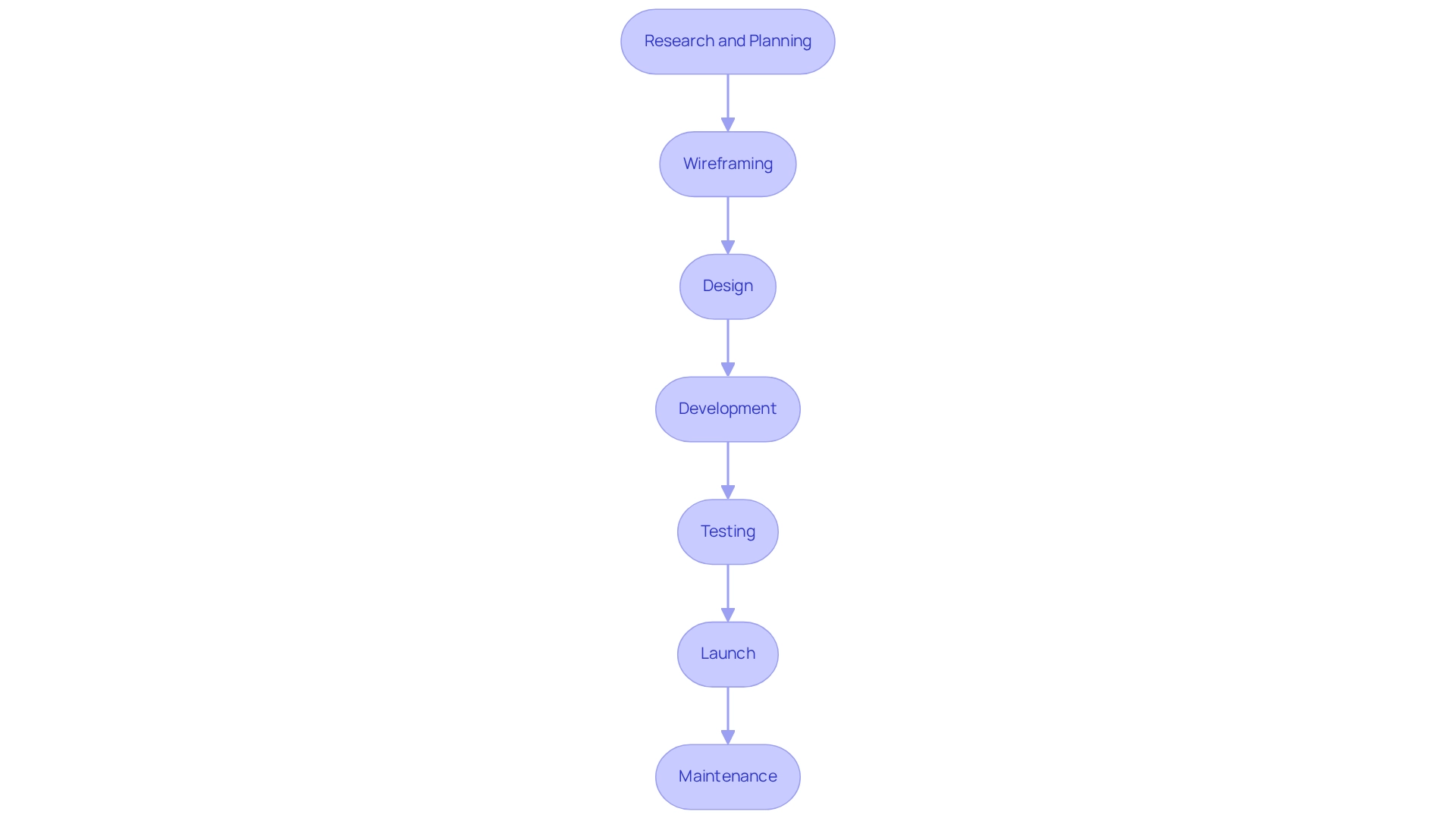
Responsive Design: Ensuring Accessibility Across Devices
Responsive layout is an essential strategy in contemporary web development, ensuring that online platforms are accessible and functional across a wide array of devices, including desktops, tablets, and smartphones. This is accomplished through flexible layouts, adaptive images, and CSS media queries that adjust the presentation based on the viewer’s screen size. As we approach 2025, the importance of adaptive layouts cannot be overstated, given that search engines are increasingly prioritizing mobile-friendly platforms in their ranking algorithms.
A well-executed adaptive layout not only enhances visitor experience but also significantly boosts SEO effectiveness. Data reveals that individuals form judgments about a site in just 0.05 seconds, underscoring the necessity of an appealing and adaptive interface. Moreover, companies that adopt mobile-compatible layouts experience tangible benefits; for instance, Oprah’s website enhancement led to an impressive 63.27% increase in demo request clicks following updates made in response to visitor feedback. This case study exemplifies how adaptive layouts can enhance audience interaction and drive conversions.
The rising adoption of mobile technologies is evident, with Google Lens being utilized 12 billion times a month as of May 2023. This trend highlights the growing reliance on mobile devices for information and interaction, further emphasizing the critical need for responsive layouts. Expert opinions reinforce the significance of responsive layouts in enhancing user experience.
A staggering 32% of individuals indicate they would disengage with a brand they once loved after a single negative experience, illustrating the necessity for seamless interactions across all devices. As mobile usage continues to escalate, the demand for adaptive layouts will only intensify, establishing it as a vital component of any effective web strategy.
Furthermore, successful client stories, such as the brand identity uplift for Castania and the digital campaign for Motorola, demonstrate how adaptive layouts contribute to measurable outcomes and enhance brand engagement.
In summary, adaptive layouts are not merely a trend but a fundamental necessity for businesses striving to excel in the digital landscape. Organizations that embrace this strategy will likely witness enhanced customer engagement and satisfaction, ultimately leading to improved business results.
The Future of Web Design: Trends and Innovations
The future of web creation is set to undergo transformative changes, driven by technological advancements and evolving client expectations. Key trends to monitor include:
- AI Integration: The incorporation of artificial intelligence is revolutionizing web creation by facilitating personalized experiences and automating various development processes. This shift not only enhances participant engagement but also streamlines workflows, making the creation process more efficient. The integration of AI is expected to significantly impact business results.
- Voice User Interface (VUI): As voice search becomes increasingly prevalent, developing for voice commands is essential. This trend enhances accessibility, allowing individuals to navigate websites seamlessly through voice interactions, which is particularly advantageous for those with disabilities.
- Sustainable Design: There is a growing focus on eco-friendly practices in web design. Designers are concentrating on minimizing environmental impacts by optimizing energy usage and employing sustainable materials, aligning with global sustainability objectives.
- Augmented Reality (AR): The integration of AR components is creating immersive experiences that engage visitors in innovative ways. This technology allows individuals to interact with products and services in a virtual space, enriching their overall experience.
- Minimalist Design: The trend toward minimalism continues to gain momentum, emphasizing simplicity and clarity. By prioritizing essential content and eliminating unnecessary clutter, designers can enhance usability and effectively direct users to crucial information. Notably, 84.6% of individuals prefer clean and simple layouts, significantly improving their navigation experience.
Understanding the nuances of web design is critical for creators and companies aiming to stay ahead of these trends and maintain a competitive edge in the rapidly evolving digital landscape. As we approach 2025, the integration of AI and VUI is anticipated to reshape web development methodologies, with data indicating that investing in user experience can yield substantial returns—$1 invested in UX can lead to a $100 return. Moreover, the preference for mobile optimization is paramount, as over 84% of visitors favor mobile websites over desktop, underscoring the necessity for responsive design strategies. Embracing these trends will not only elevate user satisfaction but also propel business success.
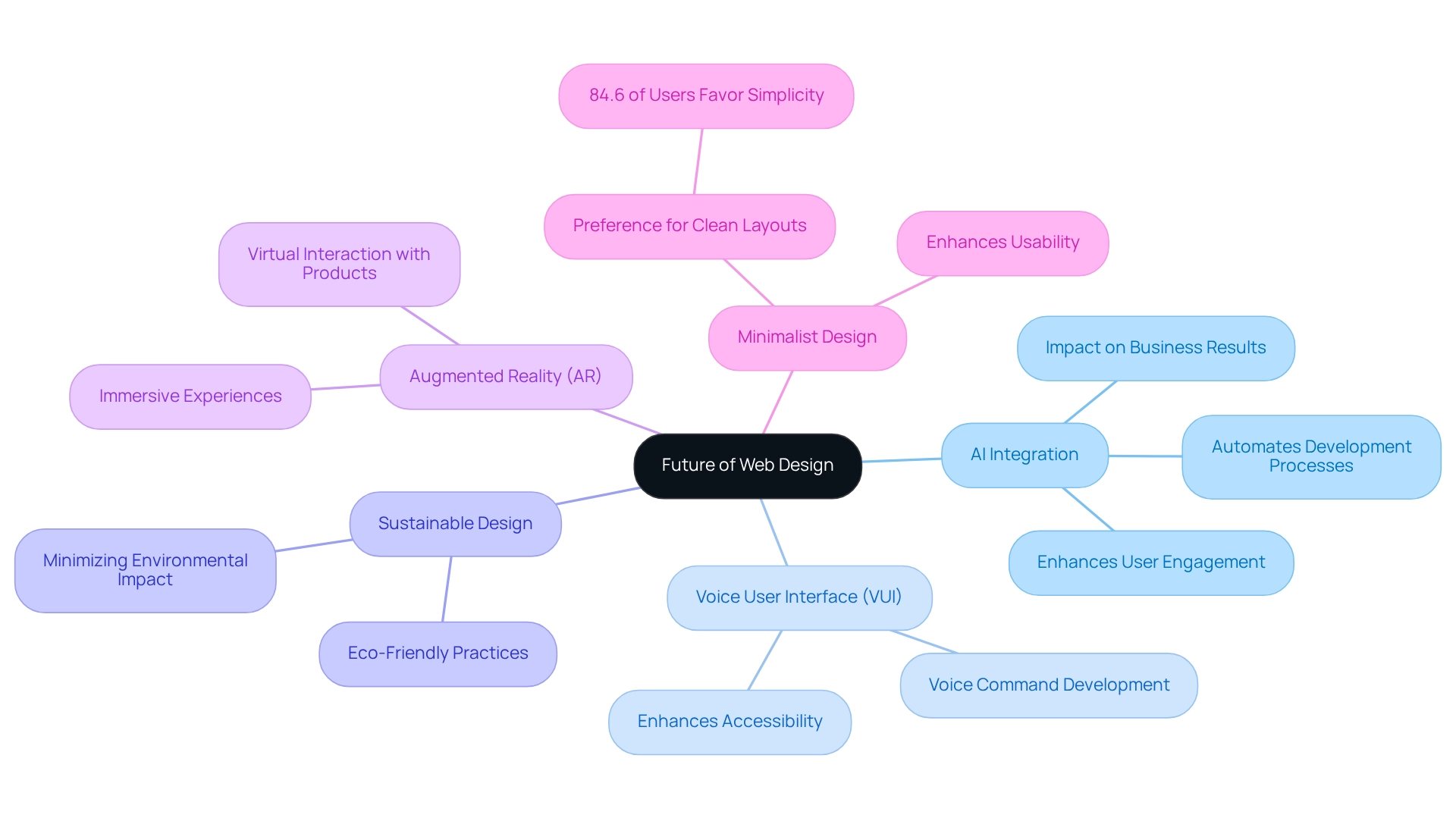
Conclusion
The exploration of web design underscores its undeniable significance in shaping brand perception and enhancing user engagement in the digital age. By understanding and implementing key elements such as layout, color schemes, typography, imagery, and navigation, brands can create compelling websites that captivate users and drive conversions. The distinction between web design and development highlights the critical importance of collaboration between designers and developers, ensuring that aesthetics align seamlessly with functionality.
User experience emerges as a central pillar of effective web design, where intuitive navigation and fast loading times are crucial for retaining visitors. As illustrated through various case studies, strategic enhancements in user experience can lead to substantial increases in engagement and conversion rates. Furthermore, the integration of essential tools and technologies empowers designers to streamline their processes and deliver impactful results.
Looking ahead, trends such as responsive design, AI integration, and sustainable practices are poised to redefine the landscape of web design. Adapting to these innovations will be vital for brands aiming to maintain a competitive edge and meet evolving consumer expectations. In a world where first impressions are often formed online, prioritizing effective web design is not merely an option; it is an imperative for success in the digital marketplace.
Frequently Asked Questions
What is web design?
Web design involves the strategic planning and development of online platforms, integrating elements such as layout, content production, and graphic design, which fundamentally shapes customer perception and interaction with a brand.
Why is web design significant for branding?
Effective web design significantly enhances user experience, attracting visitors and fostering higher engagement and conversion rates. It serves as the cornerstone of a successful branding strategy, especially as initial perceptions are often formed online.
How does page-load time affect conversion rates?
Research indicates that the first five seconds of page-load duration have the most substantial impact on conversion rates, highlighting the necessity for quick and effective layouts.
What visual components should be considered in web design?
Important visual components include images, colors, and videos, all of which enhance audience engagement and influence visitor behavior.
Can you provide an example of effective web design impacting user behavior?
Yes, Orah, a student engagement platform, revamped their homepage layout, which resulted in a remarkable 63.27% increase in demo request clicks, illustrating how strategic website creation can influence visitor behavior and brand perception.
What are the essential elements of effective web design?
The essential elements include: Layout: Strategic arrangement that guides navigation and interaction. Color Scheme: Aligns with brand identity and evokes specific emotions. Typography: Enhances readability and conveys brand personality. Imagery: Attracts attention and maintains audience interest. Navigation: Clear and intuitive structure for effortless information access.
How does navigation affect audience engagement?
Efficient navigation can lead to a 73.30% increase in traffic, underscoring its essential role in audience engagement.
What should brands consider regarding web development investments?
Brands should consider the average yearly membership expense for WordPress, which is approximately $145, when planning their web development investments.
What is the role of web design in the digital landscape as we approach 2025?
Understanding the intricacies of web design remains crucial as an essential element of branding strategies, enhancing both audience interaction and conversion achievements as brands navigate the digital landscape.



